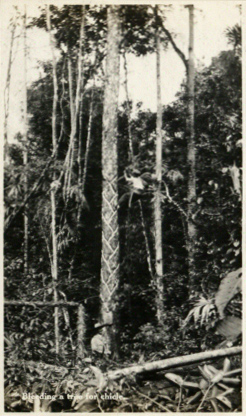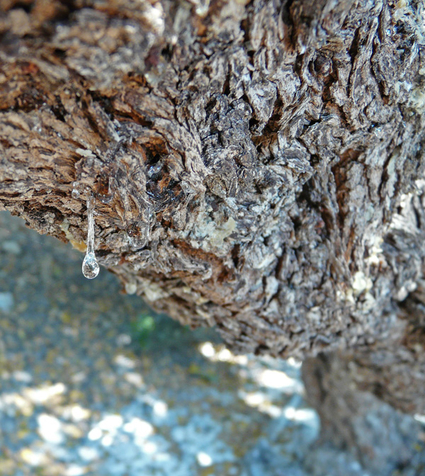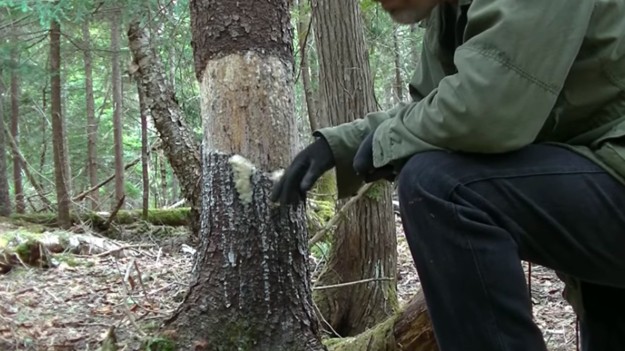Birch-bark tar
Chewing on something tacky is such an ancient practice that it is not clear what the first example of something resembling gum comes from. Possibly one of the oldest examples of gum is birch bark tar with tooth print from from 6000 years ago in Keirikki, Finland. A 5,700 year old piece of chewed birch tar was also found on the Danish island of Lolland, written about in more detail in this blog post.
Chicle, part 1
On the American continents, The Mayans are known to have chewed on resin from the sapodilla tree, known as chicle, for hundreds of years. The Mayans developed their first civilisation around 4000 years ago. In a similar geographical area to the Mayans, though at a later period, the Aztecs also chewed chicle and also developed intriguing misogynistic dynamics around the practice of chewing. Probably because of the chicle's ability to freshen breath, only unmarried women would chew it in public, whereas married women could chew in private for the benefit of their husbands. If a man dared to chew he would be seen as effeminate.
How chicle is harvested from a sapodilla tree - from The National Archives UK on Flickr 
Mastic(ation)
For at least 2,500 years, mastic ‘tears’ or mastiha, resin from the mastic tree, had been harvested in Greece. In particular, the island of Chios during the Ottoman rule (in Turkish, Chios is called Sakız Adası, meaning island of gum) found a great deal of prosperity in the harvest and trade of the resin, in the form of oil as well as gum. At its peak, it was worth its weight in gold and theft could result in execution. The supposed health benefits, including the refreshing of breath and as a digestion aid, of mastic tears are what were responsible for its highly prized nature. This is perhaps the first, or one of the first, examples of gum becoming a commodified product with a high monetary value.
Mastic tears from a mastic tree - Photo taken by Ailinaleixo from Wikimedia Commons
Spruce Tree Sap
Spruce tree sap and resin had been used by Native Americans to chew on, as well as a practical glue and salve, for some time before the early pioneers decided to appropriate this tradition for a commercial business opportunity. The most well-known in this endeavor is John B. Curtis, who is somewhat misleadingly accredited with inventing chewing gum - misleading when you consider the ancient history of the practice. With confidence, however, he can be labelled the first to market gum as a commercial product.
Curtis combined the spruce resin, beeswax and flavourings to create his gum, which he then began to sell all over the east coast of the US as a travelling salesman in 1850. Despite a slow start, the product soon quickly became popular and the production facilities had to rapidly expand. Curtis is also credited with making the largest business transaction of the 19th century, when he purchased $35,000 of raw gum material at once.
Spruce Sap being harvested - from Kullcraven Bushcraft & Survival on YouTube 
Chicle, part 2
Around this same time as Curtis travelled the US promoting his gum, the exiled Mexican general Antonio de Santa Anna introduced chicle to the New Yorker Thomas Adams. Adams’ failed attempts at creating boots, tires and toys out of chicle left him with a significant surplus of the material. Knowing about chicle’s chewable culture in South America, Adams created the iconic tutti-frutti flavoured gumball, and also Chiclets which are still popular products in the US today. Chicle also formed the base of the gum that Wrigley Jr. began to give away as a freebie alongside baking powder. As the gum was much more popular than the baking powder, this took priority for Wrigley’s business.
Synthetics
In the first half of the 20th century, Wrigley continued to base his gum on chicle. However, in 1952, Guatemala introduced measures to improve the working conditions of its farmers which proved to be too great an expense for Wrigley and he switched to a synthetic rubber base for his gum being produced in California. The Wrigley Company is now the world’s largest manufacturer of chewing gum in the world.
From its humble beginnings as a simple plant extract, gum now exists as a near $30 billion industry. We often do not think twice about spending a euro on a pack to get us through the week without any acknowledgment of the cultural history of this product.